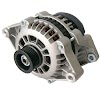Construction of Different Cables
A cable may be a single core (or) Multi core depending upon the type of service for which it is intended to be used. It may be
(i)
Single-core
(ii)
Two-core
(iii)
Three-core
(iv)
Four-core etc.
For a 3-phase systems either three single core cables (or)
three core cable can be used and it is mainly depend on the operating voltage
and load demand.
I. Low Tension (L.T cable): L.T Cables are mainly of two types,
namely
(a)
Single-Core cables
(b)
Multi-core cables
1. Single-Core (L.T)
Cable: Shows the single-core Cable. These cables are
mainly used for voltages upto 1000 volt. It consists of one circular core of
tinned stranded copper (or) aluminium is insulated by layers of impregnated
paper. The insulation is surround by a lead sheath which avoids the entry of
moisture in to cable.in order to protect the lead sheath from corrosion, an
overall serving of compounded fibrous material (jute) is provided.
1. Simple in
Construction.
2.
Electrostatic stresses developed are very small.
3.
Availability of larger Conductor section.
2. Mult-core L.T.
Cables: Multi-core
cable may be either shaped conductors (or) round conductors. Each shaped core
may have conductors of different diameters to avoid undue waste of space and
are as shown. The shaped conductors have the advantages of better copper space
factor. Each core is insulated form the other with impregnated paper. Over this
paper belts are provided. A layer wire armouring is provided on the paper belts
and finally finished with compounded fibrous material.
These L.T. Multi-Core Cables are used up to 6,600 Volts.
II. High Tension (H.T) Cables:
These cables are used for voltages Upto 11Kv and these are
generally to belted type cables. The construction details of 3-core belted
cable. The cores are generally tinned stranded copper (or) aluminium and may be
of non-circular shape to make better use of available space.
The cores are insulated from each other by layers of
impregnated paper. Another Layer of impregnated paper tape called belt paper is
wound round the insulated cores. The gap between the insulated cores is filled
with fibrous material (Jute etc.) so as to give circular cross-section to the
cable. The belt is convered with lead sheath to protect the cable from the
entry of moisture and also from mechanical injury. The lead sheath is convered
with one (or) more layers of armouring with an outer serving
Features:
1. These cables are best suitable for low and medium voltage i.e., upto 11kv because the electrostic stresses developed is radial.
2. If these cables are used beyond 22kv, the tangential stresses will come in to picture and these will act along the layers of paper insulation.
3. As the insulation resistance of paper is very small along the layers of paper. Due to tangential stresses on the cable set up leakage current.
4. Due to leakage current, enormous heat will be produced from the cable consequently at any moment the insulation may be break-down.
In order to avoid leakage current from the cables for beyond
22kv, the “Screened Cables” are used where the leakage current are conducted to
earth through metallic screens.











0 Comments